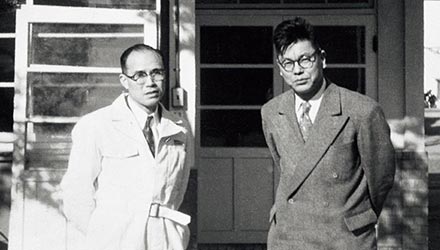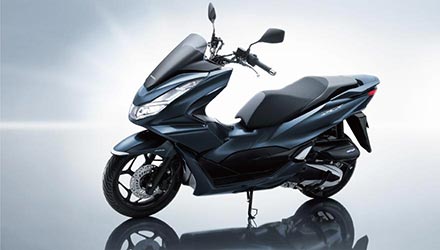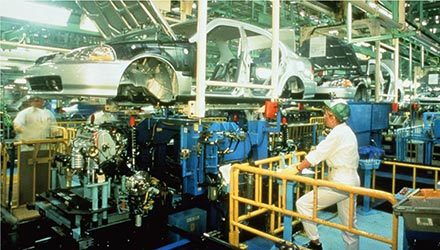Overcoming Business Crisis by Leveraging
Honda Global Network
The aftershock from the dissolution of the partnership with Rover was significant. At the time, HUM was planning to produce Honda brand models based on Rover's four-wheel drive vehicles for export to Japan, but that plan was scrapped, leaving the excess production capacity of the automobile plant in limbo. Not only did the company lose its partner in Europe, but its production volume also slumped.
Yet, Honda stayed in the European market.
Without surviving in Europe, the world’s most competitive market, Honda would not be able to maintain its competitiveness as an automaker. Honda decided to take on the European market on its own. From the late 1990s, Honda began to reorganize its business structure in Europe, optimizing excess production capacity at the engine plant that had supplied Rover, and built a second plant to strengthen its production system and renew its sales network. However, the introduction of the Euro as the common currency through economic integration in 1999 accelerated the appreciation of the yen, forcing Honda to review its production plan. In addition to producing the CR-V for Europe since 2000, HUM began production of the CR-V for North America, and the second plant which started operation in 2001, began production of the Civic. The strategy was to incorporate HUM into the Honda global network.
The Brilliance of Honda i-CTDi Engine,
Widely Acclaimed in Europe
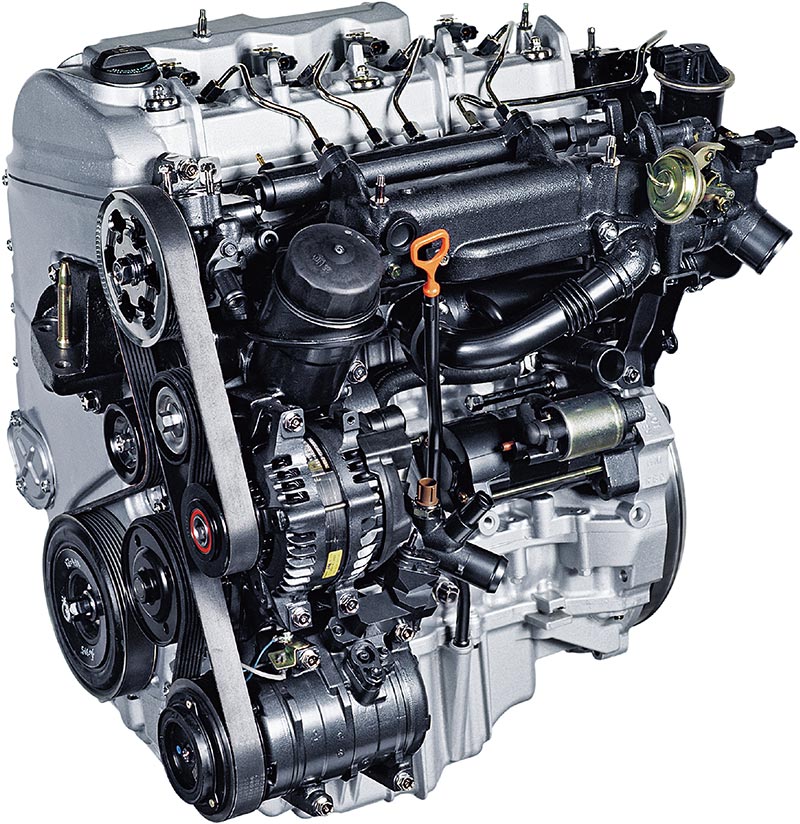 The i-CTDi was a Honda breakthrough to escape the stagnation in Europe.
The i-CTDi was a Honda breakthrough to escape the stagnation in Europe.
HUM’s opportunity to overcome its problems had arrived. The breakthrough came with the unique Honda diesel engine, the i-CTDi. In Europe, soaring gasoline prices and the increase of greenhouse gases such as CO2 that had become a serious issue since the mid-1990s became social issues, and so-called new-generation “eco-friendly and clean” diesel engine vehicles were being launched. In the early 2000s, 70% of passenger cars in France were powered by diesel engines, and they were overtaking gasoline-powered cars in Europe. Seeing that this was not a temporary trend, but would become mainstream in the European market, Honda embarked on development of its own diesel engine. Honda successfully converted the cylinder block to aluminum using a proprietary semi-solid casting technology, resulting in a diesel engine that was not only lightweight, but also outperformed the European manufacturers in terms of fuel efficiency and power output, and further strengthened the status of Honda as a world-leading engine manufacturer.
The Honda diesel engine first appeared in the 2004 model Accord Diesel, followed by the 2006 model HUM CR-V and Civic, contributing significantly to the increase in Honda sales in Europe.
Shigeru Takagi, then HME President, said: “Honda diesel engines have been very well received by people in Europe. We have very many people saying, ‘Honda, you finally did it!’ By adding diesel-powered cars to our lineup, we may have signaled that Honda is listening to its European customers.”
Honda in Europe realized its Three Reality Principle (go to the real place, understand the real issue and make realistic decisions). Miyake said: “We were manufacturing products with specifications and quality that meet the needs of each market, and satisfying the people who buy them."

In 2000, production of the CR-V began.
All-New European Civic Developed by HUM
With the introduction of the Honda diesel, production suddenly came to life. HUM took this opportunity to make a major move, introducing a new model exclusively for the European market. Honda chose its iconic Civic. Since the first generation was introduced to the European market in the mid-1970s, the Civic had gained a strong fan base due to the uniqueness of Honda vehicles unlike European cars. However, since the beginning of the 2000s, the Civic had been taking on a conservative image, favored by older Honda car enthusiasts.
Takagi said: “We needed to expand our customer base once again and rejuvenate the image. We concluded that it is essential to offer cars that are suited to European customers, and attractive products that can compete in the European market.”
After thoroughly studying the needs of the European market, a completely original Civic was released in 2006, differing even in the platform from the Japanese and American variants. Research in Europe showed that the market was divided into two: a practical minivan-like market and a premium, upscale market. The solution for Honda was to create a design that satisfies both types of demand. With the new, European Civic, Honda succeeded in gaining new fans in European countries.
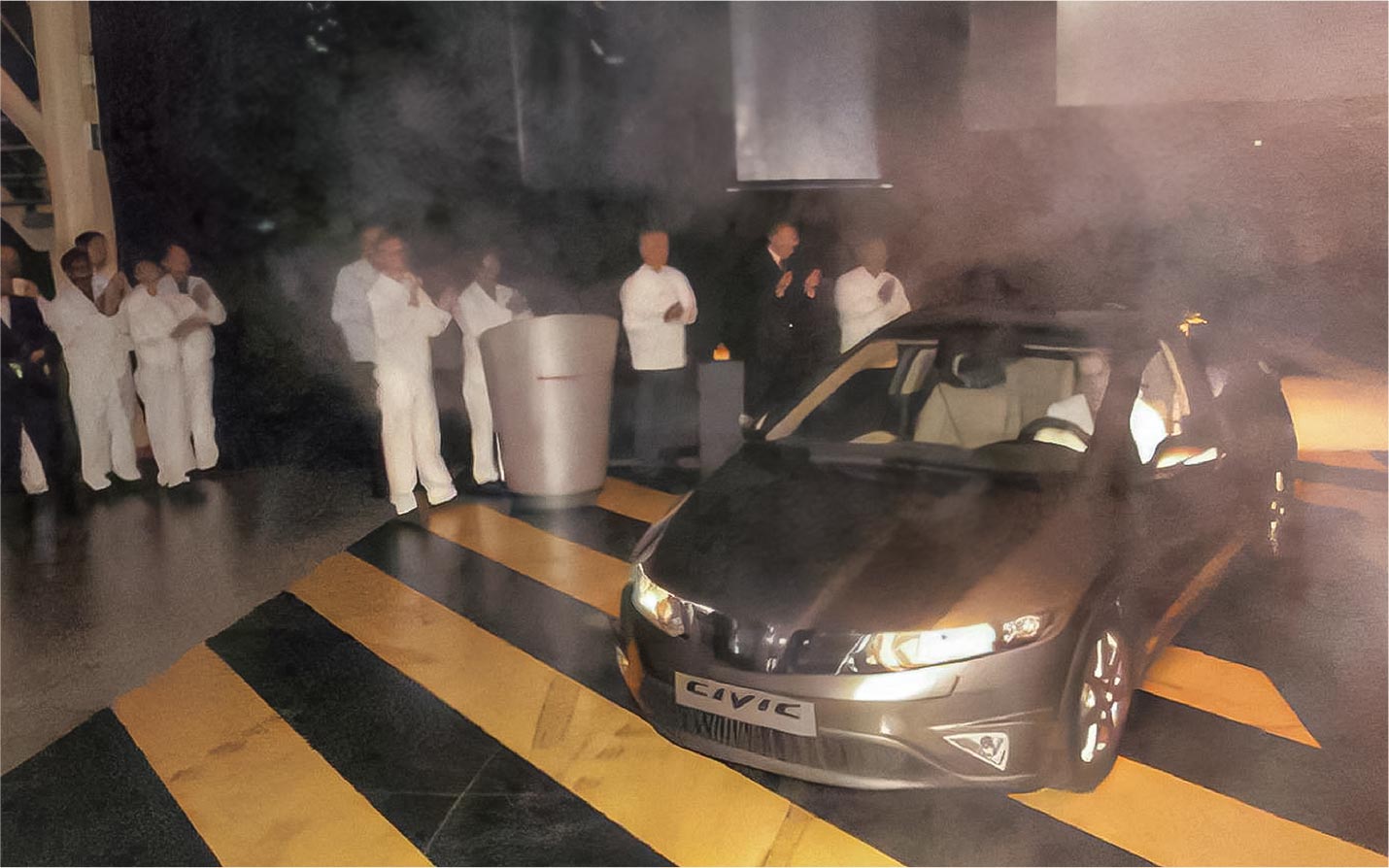
European Civic, completely produced at HUM, rolls off the line.
HUM was re-energized not only because of popularity in the market. 20 years after its founding, HUM had successfully launched a European Civic with motherless*7 production for the first time. Until then, most of the production systems had been established in Japan and transferred to HUM. Motherless production entails a greater challenge, as the regional organization would be completely responsible in resolving any issues. This was a new experience for HUM. The Civic challenge brought out HUM's potential in a big way.
Masaaki Kato, then HUM President, said: “Doing what’s obvious will not make you competitive. You have to challenge yourself, even if you have to push yourself to the limit. People only grow by taking on challenges.”
HUM's growth was the result of the unique Honda Challenging Spirit taking deep roots in Europe.
- The production of models not produced in Japan

In 2007, HUM celebrated the 1 million unit production milestone.
Pioneering Europe with the Spirit of
“Believing Our Own Strengths”
The challenge of the European automobile market, beginning with the Rover alliance, was a continuous battle to find a vehicle that would truly please the market, and a production system adapted to the local market.
Nobuhiko Kawamoto, then global president said: “I’d like to say, ‘we made progress in our autonomy with our motorcycle business, and power products business was also gaining ground, through our own efforts. Even with automobile business, our four-region global structure made it easier, so we should be able to do it. Let’s believe in ourselves. Don’t rely on others. We won in F1TM*8, and we can do it when we try. We have built a success story so far. This is not something that others did for us, we did it ourselves.’ This confidence and belief is the source of building our tomorrow.”
Let’s believe our own strengths, not rely on others – The Honda challenge in Europe succeeded because of these words.
- Formula One World Championship
Changes in European Automobile Business
After peaking in 2007, automobile sales have been on the decline in Europe.
In an increasingly competitive environment, Honda sales in Europe became sluggish, and combined with the long-term trend of the strong yen against the euro, the company faced difficult business conditions.
In 2013, in order to accelerate efficiency and strengthen the business structure, the sales subsidiaries in European countries were integrated into HME, and organizations in each country became branches of HME, before being consolidated into 10 branches in 2014.
In 2015, for the purpose of strengthening Regional Operations in Europe by utilizing resources of All Honda, the strategy planning that had been handled by HME was moved to Japan, with HME concentrating on execution of the strategy to speed up and further improve the efficiency of policy development.
Various changes, including political and market environments, were occurring at an extremely rapid pace in various regions of the world. The automotive business environment was also undergoing a major transformation on a global scale, including the CASE*9 direction. In 2019, Honda began reviewing its automobile production system under its policy of optimizing global production positioning and capacity.
In order for Honda to survive under these circumstances, it is necessary to provide products that meet customer needs more rapidly and to continue creating new value for the next generation. On the other hand, while it is necessary to strengthen its lineup of electric vehicles, Honda views the production of electric vehicles within Europe as difficult from the perspective of competitiveness and other factors. The decision was made to end production at HUM and Honda Turkiye A.S. (HTR), the complete vehicle automobile production bases in Europe, in 2021.
- CASE (Connected, Automated, Shared, Electrified) represents new areas of automotive technologies
Honda Takes on Challenges Toward the Realization
of Carbon Neutrality by 2050
In 2015, the Paris Agreement with its greenhouse gas reduction targets was adopted at the 21st Conference of the Parties (COP21) to the United Nations Framework Convention on Climate Change in Paris, France.
The Paris Agreement set a goal of achieving virtually zero (carbon neutral) greenhouse gas emissions by the latter half of 2050 in order to limit the increase in global average temperature to 1.5°C above pre-industrial levels. Since then, EU countries have actively embarked on environmental policies toward carbon neutrality, and are vigorously promoting the growth of zero-emission vehicles (ZEVs), especially battery electric vehicles (BEVs), through tax exemptions and purchase incentives for BEVs, and support for the development of charging infrastructure.
Honda aims to realize carbon neutrality for all of its products and corporate activities by 2050. As the world's largest power unit manufacturer with a combined annual production volume of 30 million units of motorcycles, automobiles, power products, outboard engines, and aircraft, Honda is committed to pursue carbon neutrality for a wide variety of products and their power sources in order to offer a broad range of solutions that fulfill customer needs in all countries and regions.
HME Senior Vice President Tom Gardner said at that time: “In Europe, the shift to electrification is happening faster than anywhere else in the world due to the fast pace of change in regulations, markets, and consumer behavior. As the pace of change continues to accelerate, we need to act faster to meet these challenges head on.”
In October 2019, Honda announced that it would further accelerate its electrification plan in Europe, aiming to electrify its main automobile products sold in Europe by 2022, three years earlier than its global electrification target. In addition to the hybrid-electric CR-V and HR-V, Honda announced a series of electrified models including the Jazz. Furthermore, Honda unveiled the Honda e, its next-generation electric vehicle (EV) in January 2020.

Next-generation Honda electric vehicle, the Honda e
 e:PROGRESS, Europe’s first energy management service for EVs by an automaker, launched in the UK to achieve carbon neutrality by 2050.
e:PROGRESS, Europe’s first energy management service for EVs by an automaker, launched in the UK to achieve carbon neutrality by 2050.
The development of charging infrastructure is critical for the Honda e to operate. In 2021, Honda launched e:PROGRESS, an energy management service for EVs in the U.K. that both utilizes renewable energy and reduces charging costs. e:PROGRESS helps to equalize electricity demand and increase the use of electricity derived from renewable energy sources, by charging EVs during periods when the demand and cost of electricity is lowest. This is the first energy management service by an automaker in Europe*10 and is offered to Honda e owners.
In March 2022, Honda unveiled the new Civic with e:HEV powertrain technology as standard equipment. With this, Honda achieved its mission to electrify all five of its major European models by the end of 2022.
Gardner said: “The achievement of our electrification goal is an important moment for Honda in Europe.”
In order to further accelerate electrification in Europe, Honda announced that it would expand its electrified lineup by introducing three new models in May 2023: the ZR-V, the e:Ny1 B-segment electric SUV, and the CR-V PHEV/HEV - a wide variety of electrified models to meet the wide range of customer needs.
For motorcycles, Honda took an important first step toward achieving its goal of carbon neutrality for its entire lineup by the 2040s, by releasing the EM1 e: electric motorcycle for young motorcyclists in Europe in summer 2023. EM stands for Electric Moped*11, and as the future form of mopeds, which has been popular in Europe for a long time, the EM1 e: targets young riders seeking easy and fun urban transportation.
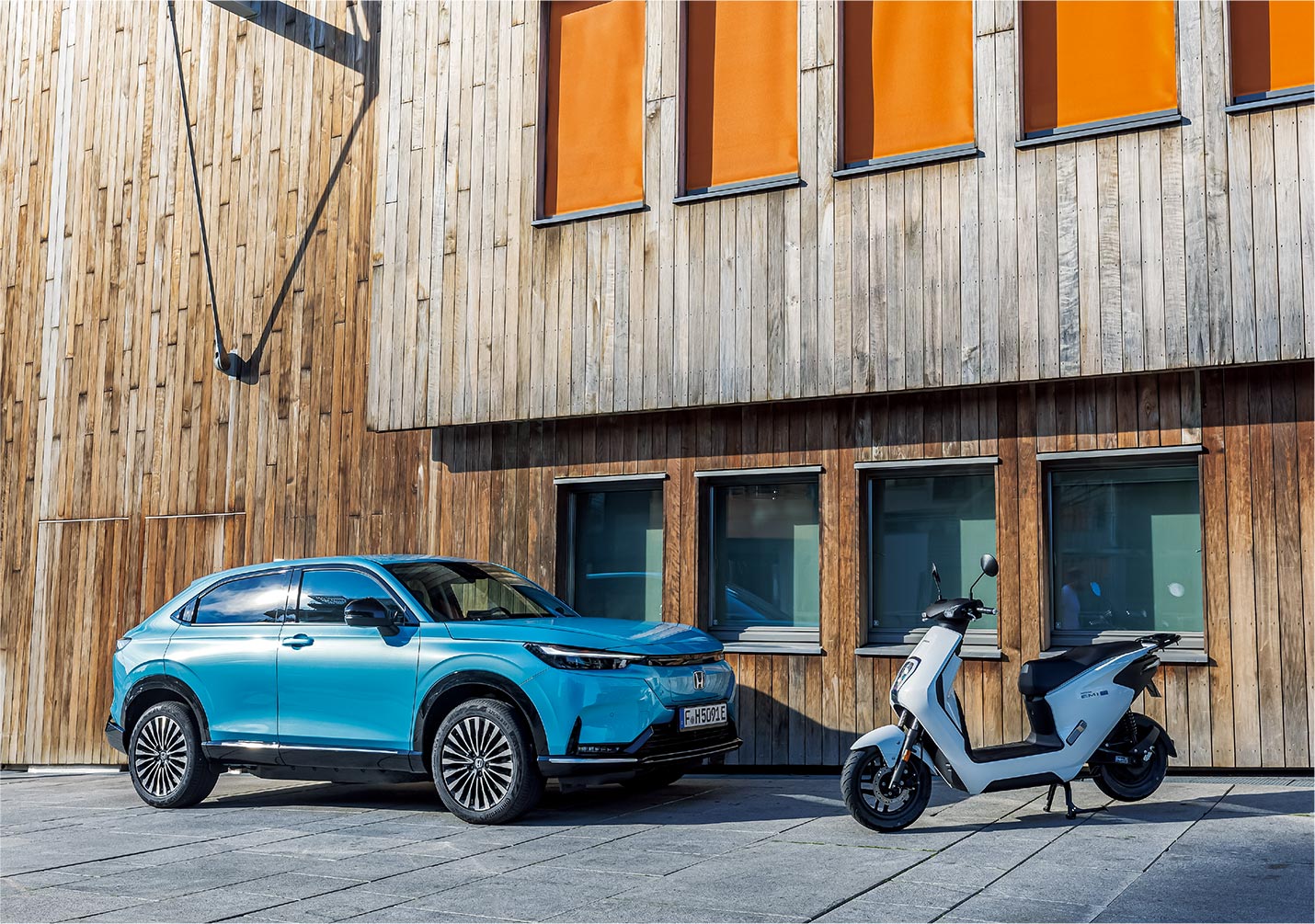
Newly launched in the European market: the e:Ny1, a B-segment electric SUV, and the EM1 e:, the first electric motorcycle to be sold in Europe.
 eGX electrified power unit with excellent installation compatibility with Honda GX Series engines.
eGX electrified power unit with excellent installation compatibility with Honda GX Series engines.
In the area of power products, Honda launched the eGX electric power unit for commercial-grade work equipment. By ensuring maximum installation compatibility with GX engines, which have been adopted by a large number of work equipment OEMs, the eGX can be installed in a wide range of work equipment, and Honda is promoting its widespread use in Europe. Taking advantage of the characteristics of the electrified power unit, the eGX-powered work equipment accommodates the needs of customers who want to use the equipment in places where it is difficult to secure adequate ventilation and in environments where users want to avoid equipment noise, such as during nighttime and in residential areas, while also contributing to zero emissions.
The next stage of Honda electrification is its global, multi-pathway strategy. To realize its commitment to carbon neutrality for all of its products and corporate activities by 2050, Honda will invest heavily in a variety of zero-emission technologies, including EV batteries, Honda Mobility Power Pack (MPP) swappable battery system, carbon-neutral fuels, and fuel cells.
In April 2021, Honda announced that it aims to increase the new vehicles sales ratio of battery-electric (EVs) and fuel cell electric vehicles (FCVs) to 40% by 2030 and 80% by 2035 in all major markets of electrification combined, including the European region. In the same month, Honda announced that it would discontinue sales of new vehicles powered by internal combustion engines (ICE) worldwide by 2040.
- Honda internal research
- Electric Moped (maximum speed of 25 km/h - 50 km/h) category
Past, Present and Future of Honda in Europe
After the end of World War II, the former West Germany and all of Europe made a remarkable recovery. On the other hand, few modern Japanese industrial products were imported into Europe, and Europeans had little to benefit from Japan's postwar industrial development.
From the perspective of European manufacturers that had developed modern motorcycles such as BMW and NSU, Honda was merely a newcomer from the Far East, and the general public was not even aware that Honda was producing motorcycles in Japan.
However, in the early 1960s, Honda was already the world's largest producer of motorcycles.
That is why, following its entry into the U.S. market, Honda, as a pioneer in the motorcycle industry, aimed to enter Europe by “sending a large volume of original and modern Japanese industrial products to Western European markets on a continuous basis,” and established EH, its first sales operation in Western Europe, in Hamburg, a free trade port in the former West Germany, to strengthen its complete vehicles and supply parts sales and service. That was when Honda began making its own history in Europe. Honda decided to enter the European market with a dream to take on challenges and deliver motorcycles that would be chosen and appreciated by European customers. This is also true for Honda automobile business in Europe.
However, Europe, is a collection of nation-states with a dynamic and complex history, with different industrial structures and diverse ways of thinking and living environments. The challenge Honda decided to take on was difficult from the beginning. However, Honda did not give up on its chosen path, but instead worked with local people, built trust with local companies, produced its products close to the customer, and earnestly pursued the return of profits to the local communities. By doing so, Honda aimed to integrate into European society and establish a one and only Honda brand.
2023 marks the 62nd year of this challenge. During this time, the industrial structure, demographics, and values of European society have changed dramatically. 62 years is a significant period of time, and although Honda has accumulated a great deal of experience, it is most likely only the first stage of its history. Honda Europe believes it is just beginning the second stage.
Considering the first stage of Honda business development in Europe was centered on making engines with reliability, durability, and high environmental performance, the second stage will be an era of new business development challenges, focusing on the mobility and energy fields, while leveraging the foundation that has been cultivated to date. The decision Honda made to close its European automobile production operations (HUM/HTR) also represents a change in its European expansion strategy, in light of the major trend of electrifying markets amidst changes occurring in each region, such as market trends and tighter environmental regulations.
In terms of its presence in Europe, Honda needs to strengthen its brand by developing businesses that respond to the new values of today's Europe, based on the trust it has earned from many customers. Honda will make the brand shine, continuing to take on the challenges that go with the innovations made in Europe.


